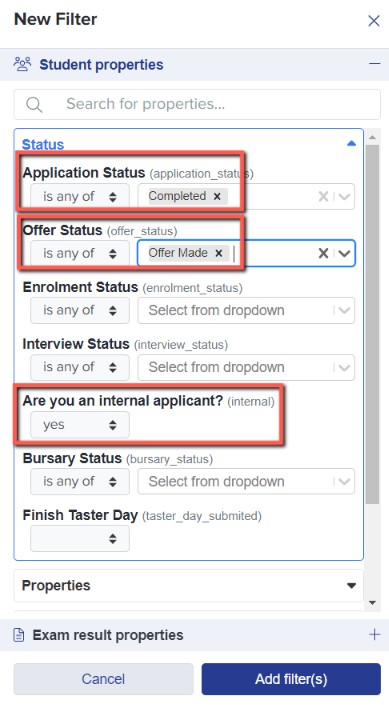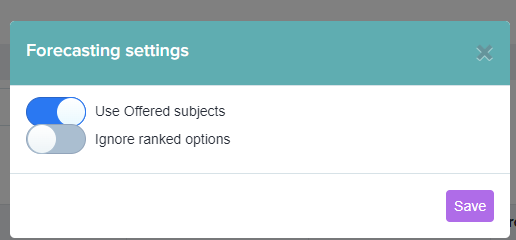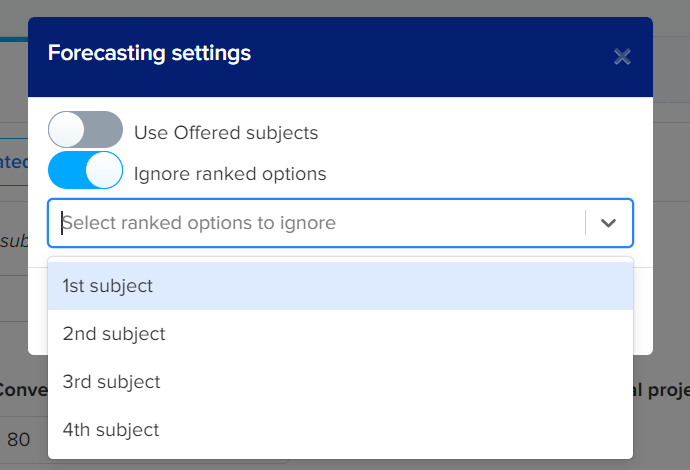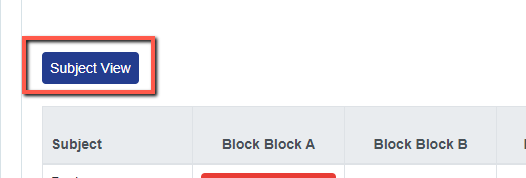Timetables Area - Timetable Forecasting
This guide will tell you how to use Timetable Forecasting.
To get to this section, you first need to click on "Timetables" on your dashboard.
It will then load this page, where you can click on the "Forecasting" tab:

Note: the forecasting feature does not use applicants' reserve subject choices.
The forecasting section enables you to actually use the data that your system is gathering from applicants to see how suitable your current block configuration is. It allows you to test out ahead of time if you need to make any changes to your blocks, whether it be adding new classes or moving some, if you're not getting enough interest.
The first thing you'll be able to do is filter for which candidates you want to include in this exercise. For example, you may want to prioritise applicants that are internal and completed, who you have made an offer to. Use the "filters" menu to choose and apply filtering like so:

You can then set your conversion rate. The default setting is 80% but you can edit this to reflect your own experience. Setting this will then alter your number of projected students, like so:

You can also click the settings cog on the right of the screen to choose whether or not to factor in their ranking of applied subjects, and if you have made offers to your applicants you can use their offered subjects, rather than their applied subjects:

If you select the "ignore ranked options" you can then choose which ranking to ignore. For example, if you are allowing them to choose 4 options but your priority is their top 3 choices, you could select to ignore their fourth ranked choice:

Based on the settings you have put in place, the table will display the numbers of applicants by subject, including the total applied, the filtered number and the projection for enrolment, as well as the number of classes you have set up for each subject.

In the example above, each class has been set to require a minimum of 10 students to be viable. Subjects where the projected numbers meet this requirement will be shaded green, and those which do not are shaded red - it gives you a visual indication of which subjects may not be viable to run, or which subjects have too many classes under your current structure.
The next table down will use the information from table 1 to allocate your applicants to the best fit of classes, based on the classes and blocks you have currently got in place. You can click the "allocate applicants" button each time you make changes to your filtering above, to see what differences this makes. This feature auto-balances class sizes for you.


You can click on the number of unallocated applicants to view their choices and see what is creating the clashes.

This will help you to make any decisions about whether to set extra classes up, or move the existing class to a new block.
Subject view will show you the number of times your subjects are clashing together, so you can decide whether it is worth making changes.

For example, subjects which are clashing a lot may need moving, but if there are only a couple of students with clashes in those subjects you may decide to leave them where they are.

You can then make block changes in your timetable overview area and go back into forecasting to reallocate the applicants again. This will apply the changes made and will show you the new figures for any unallocated applicants.
Each time you use this area, you can choose to export the information into a spreadsheet, or save the view - this allows you to come back and use the view again without needing to set it up each time:
